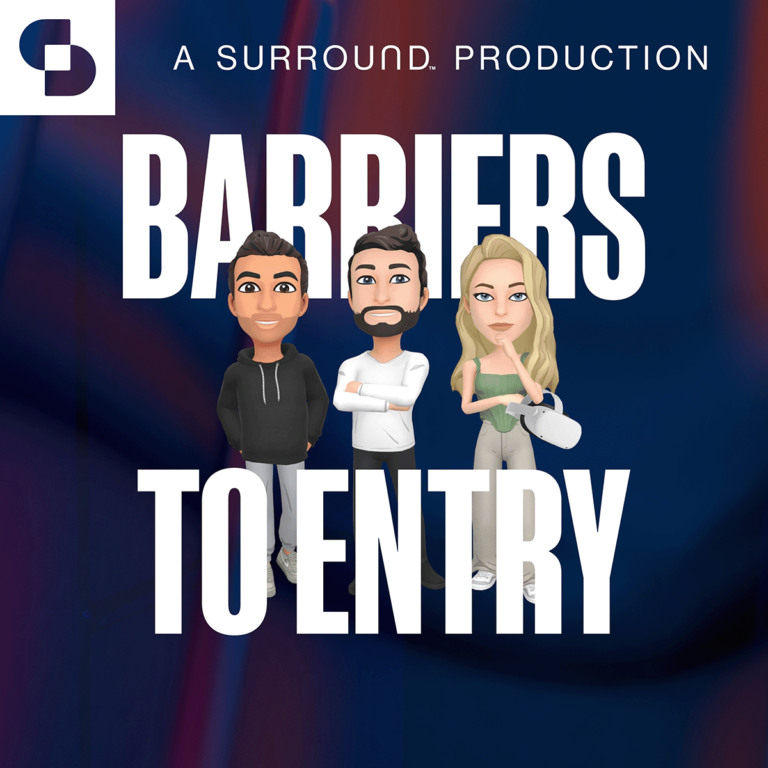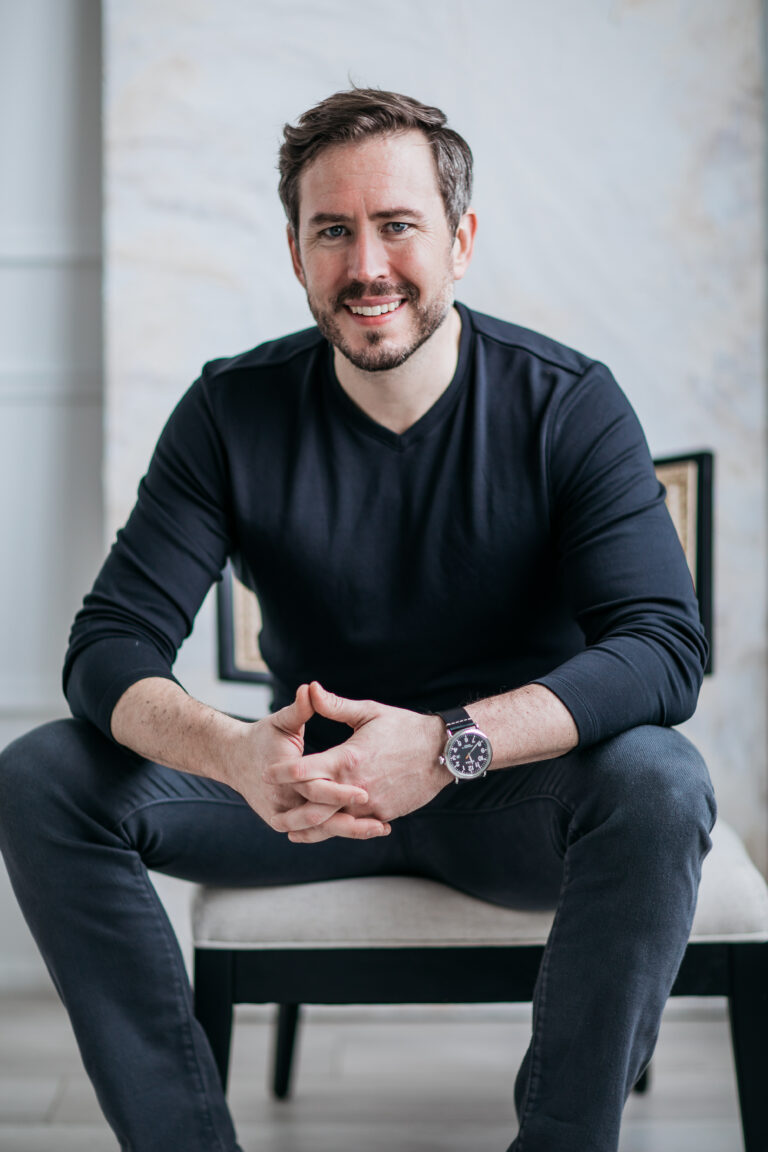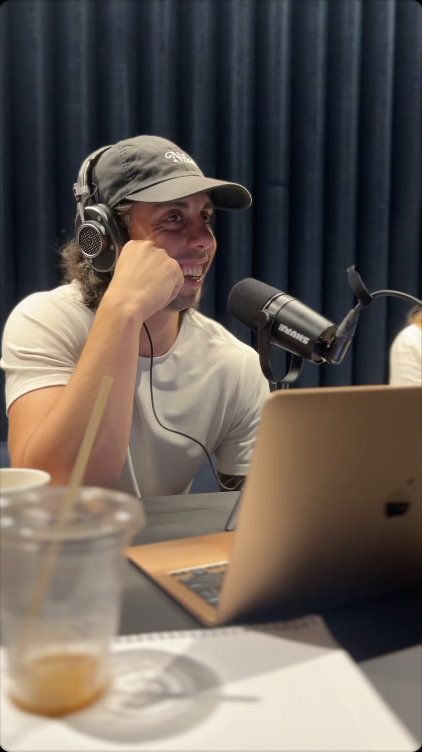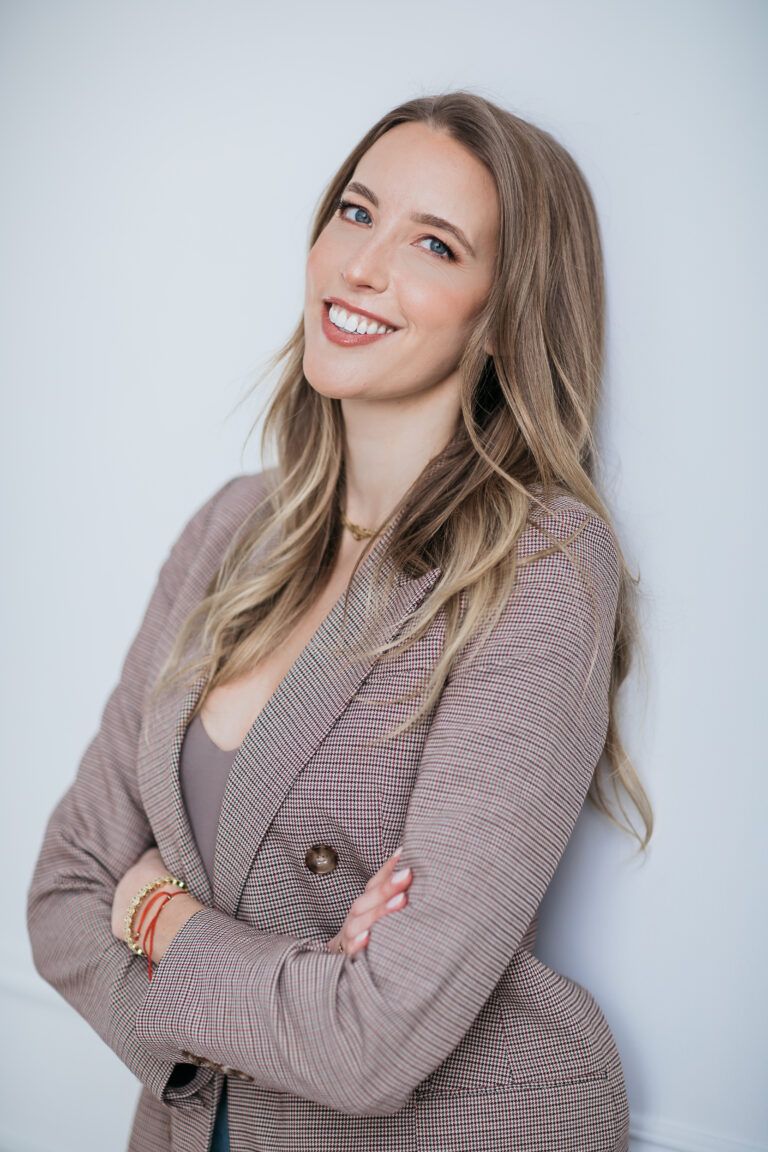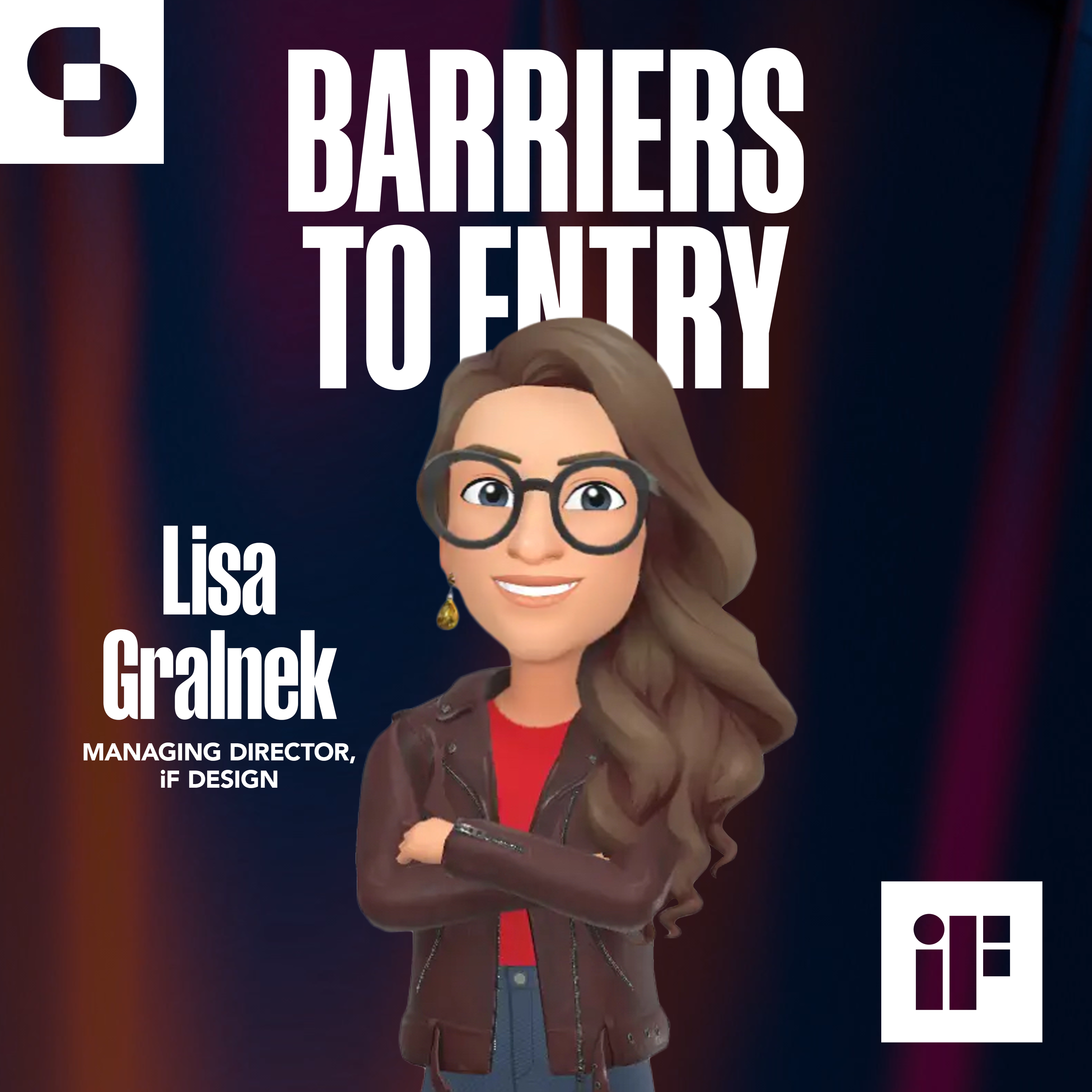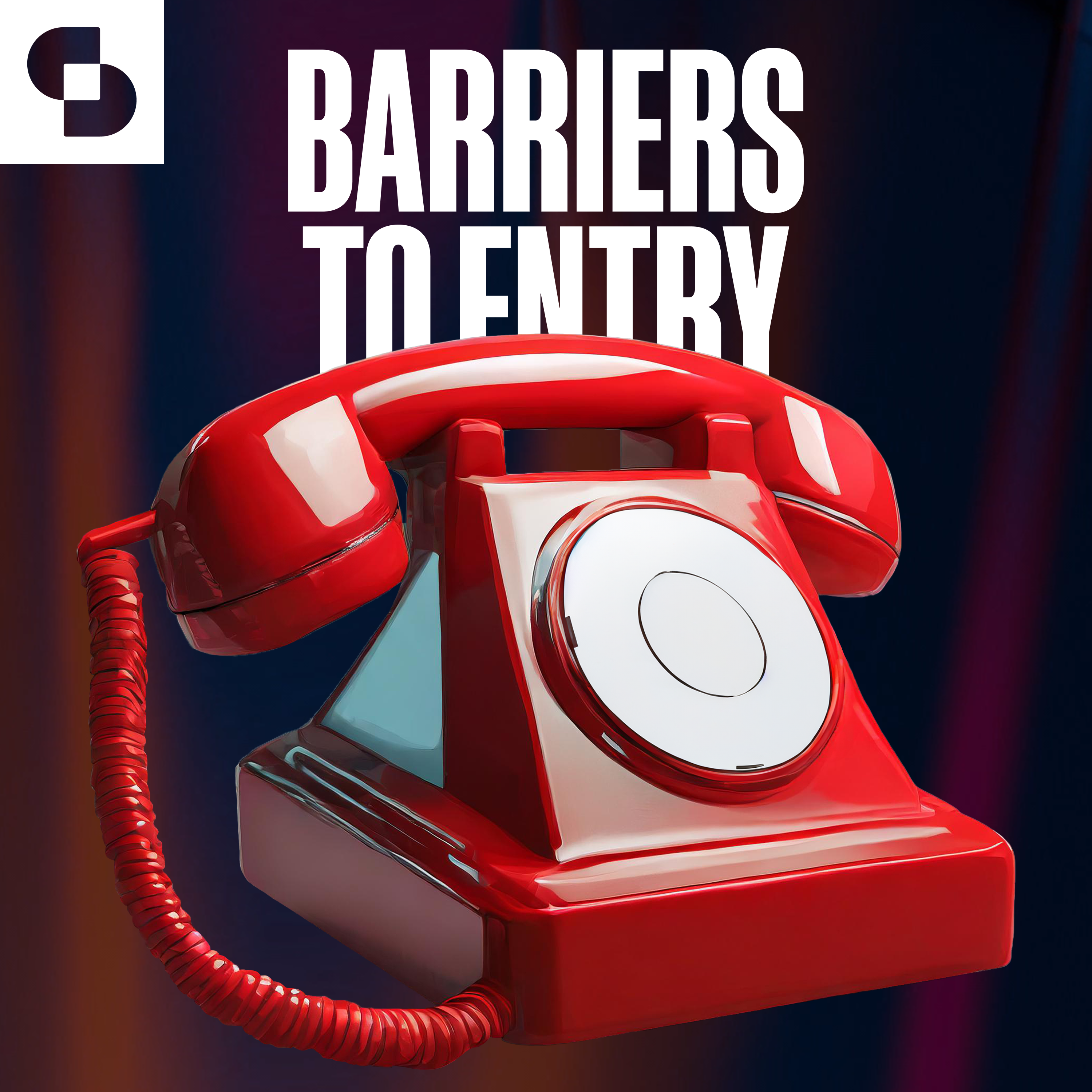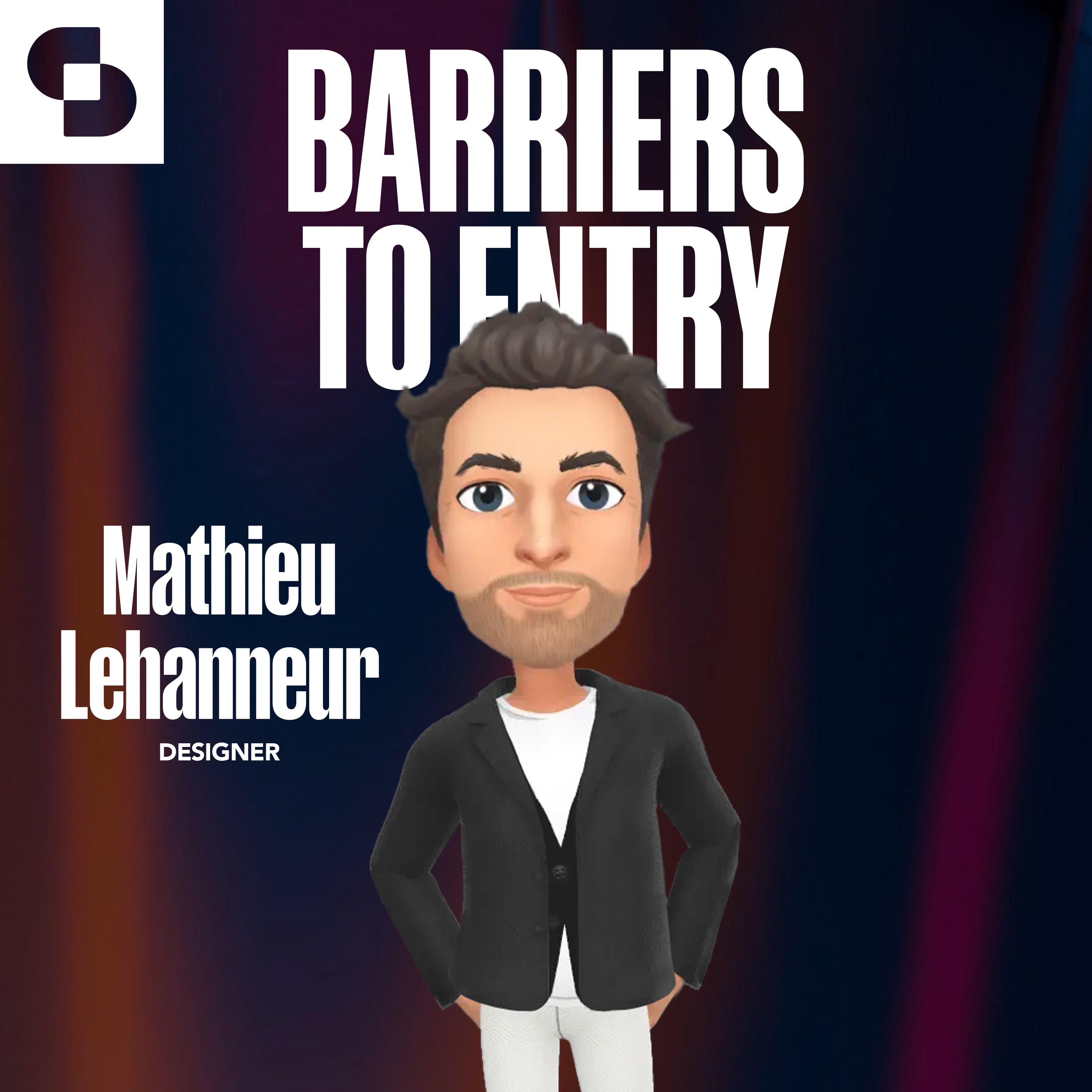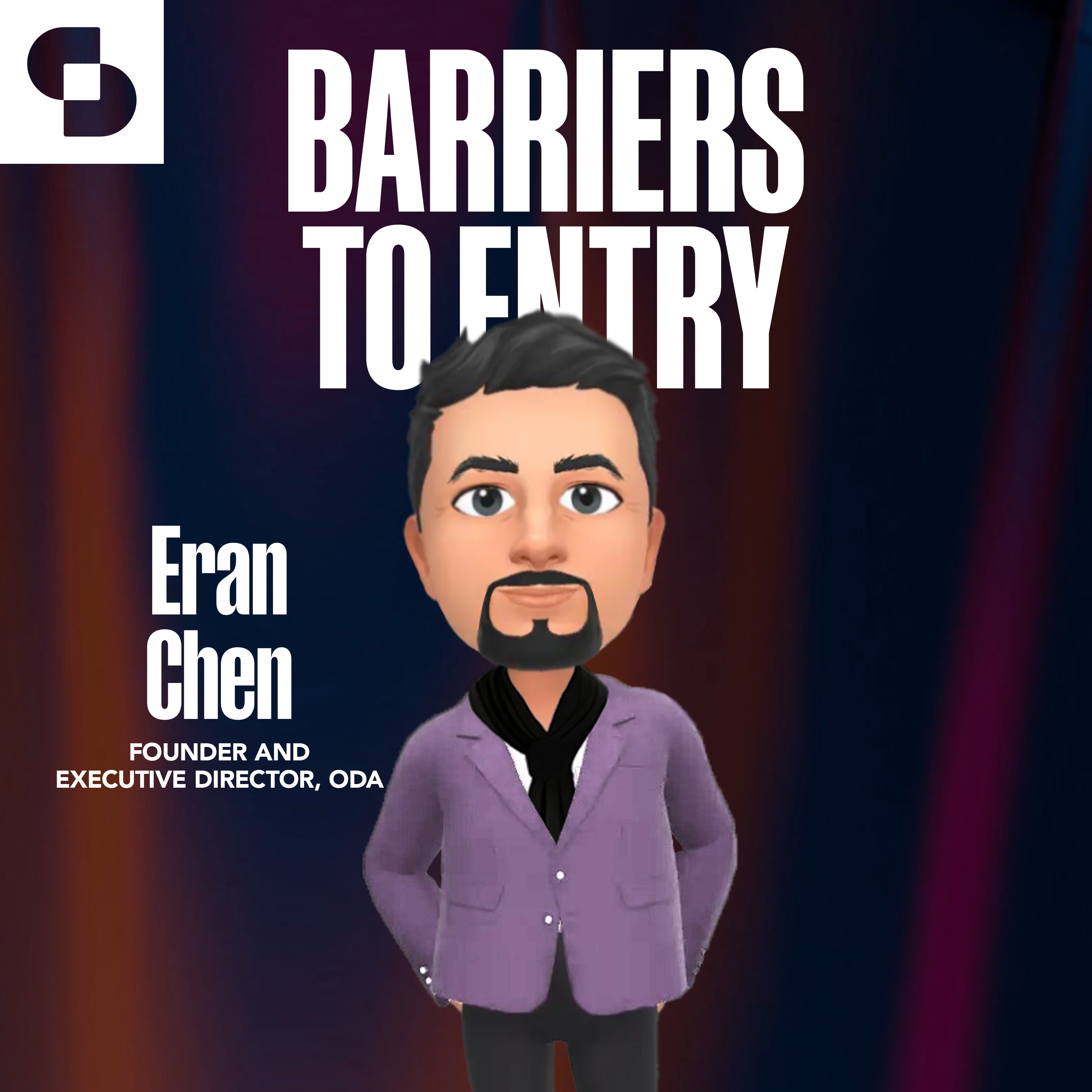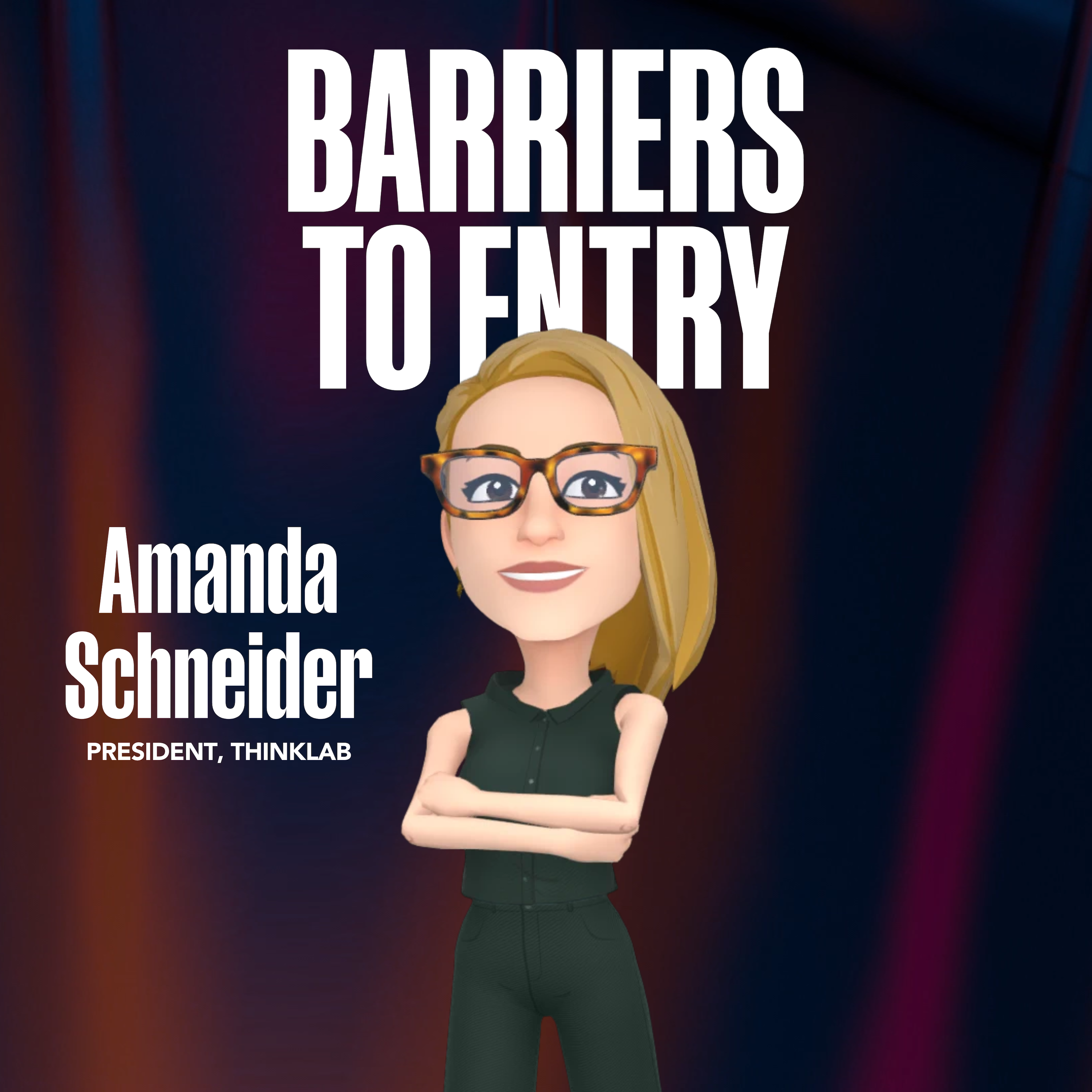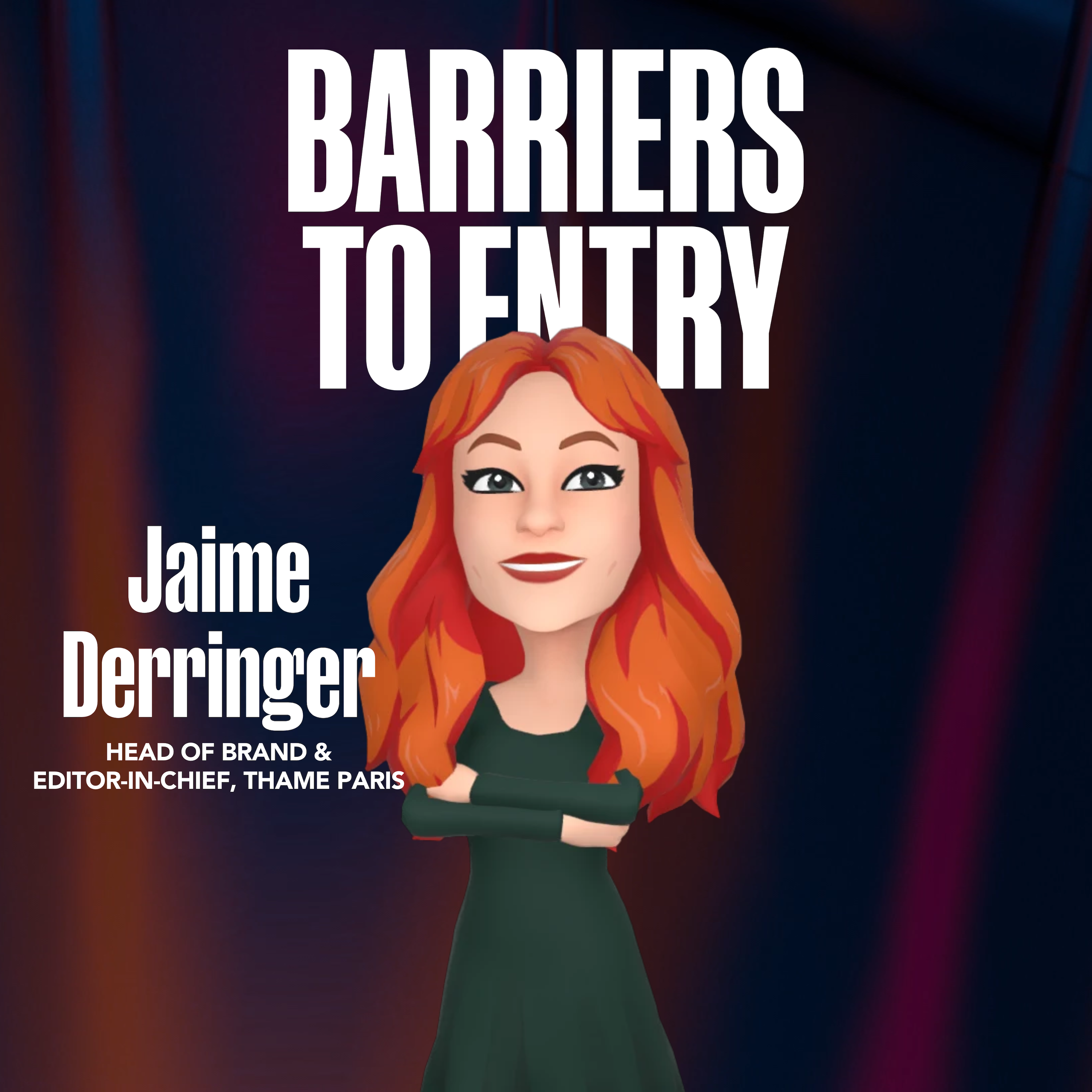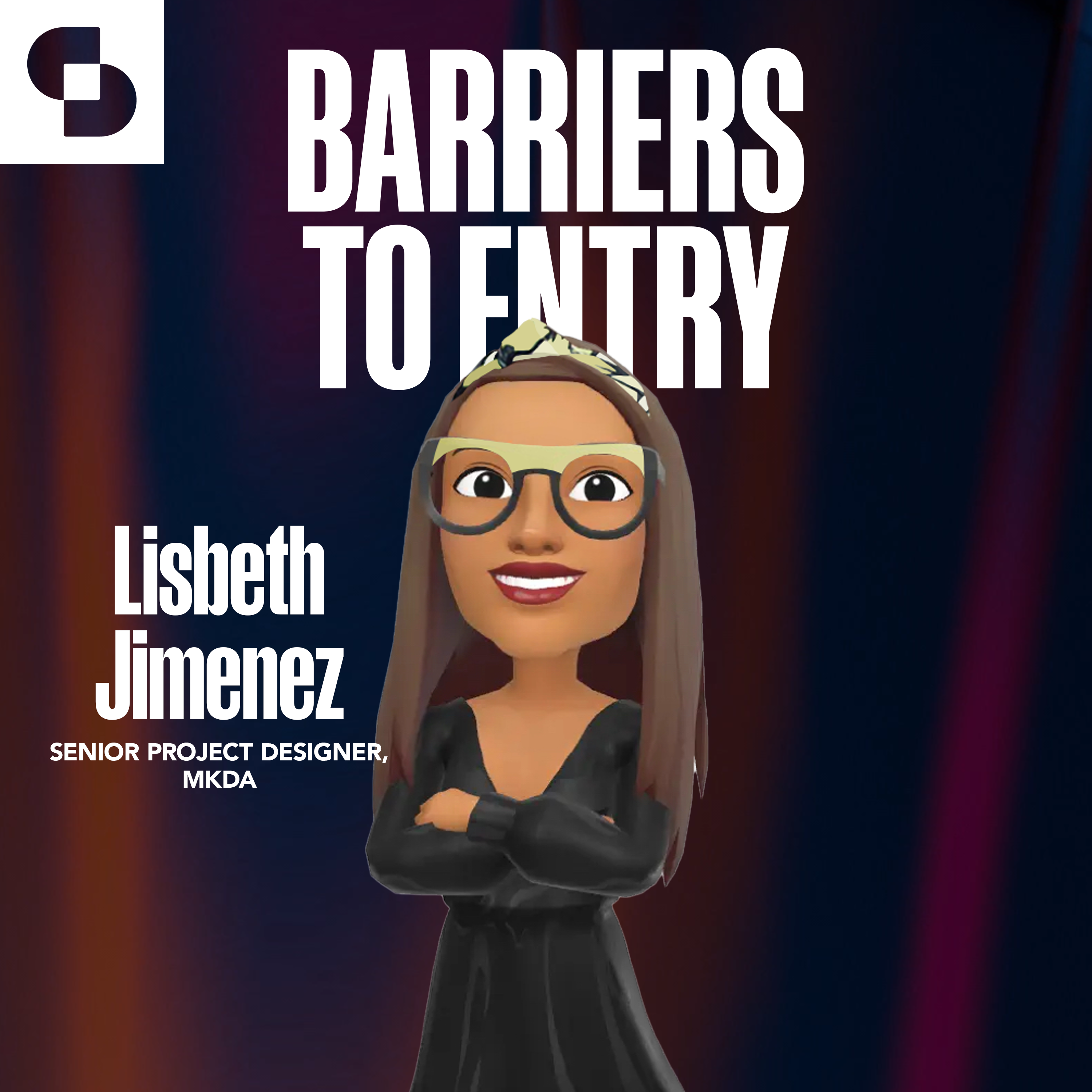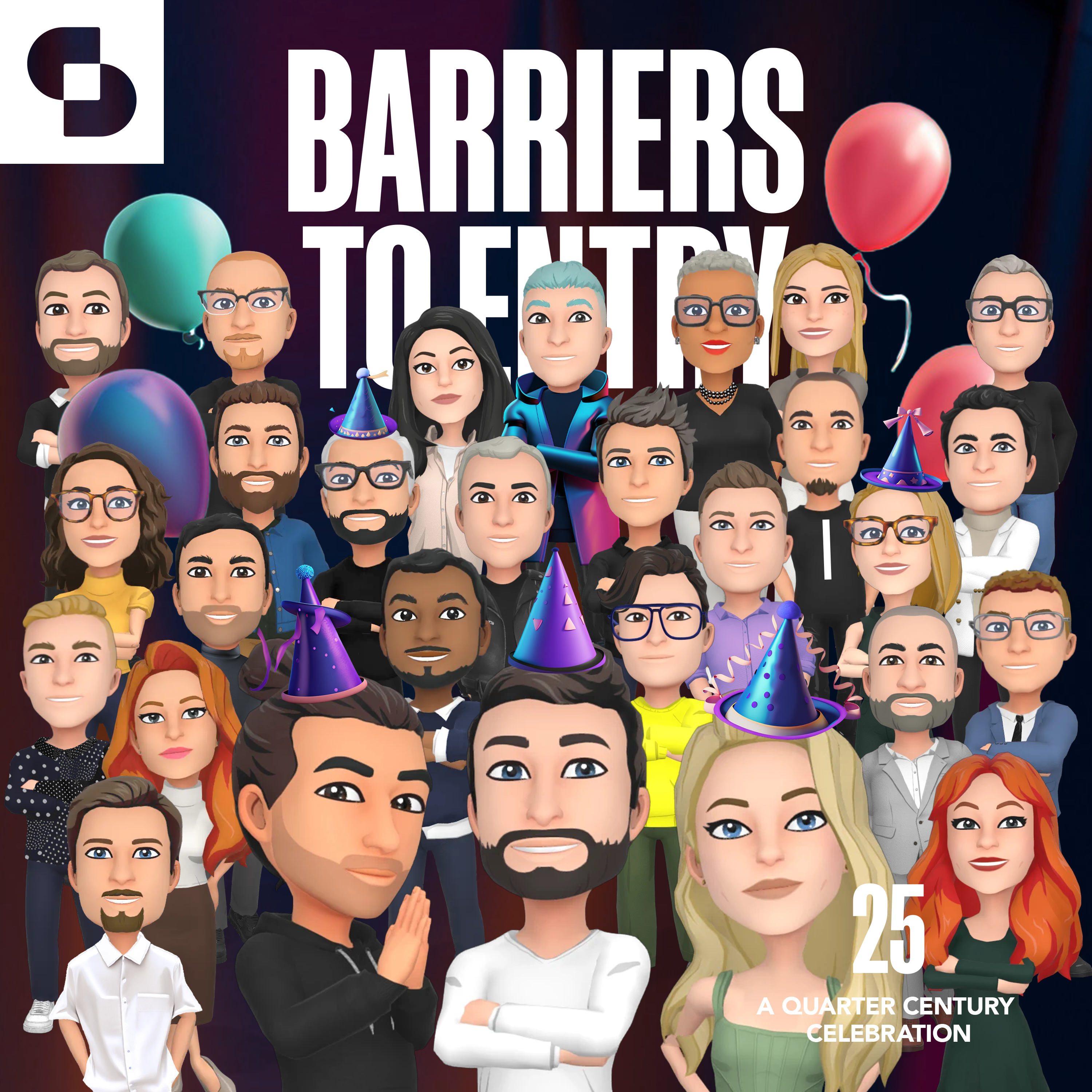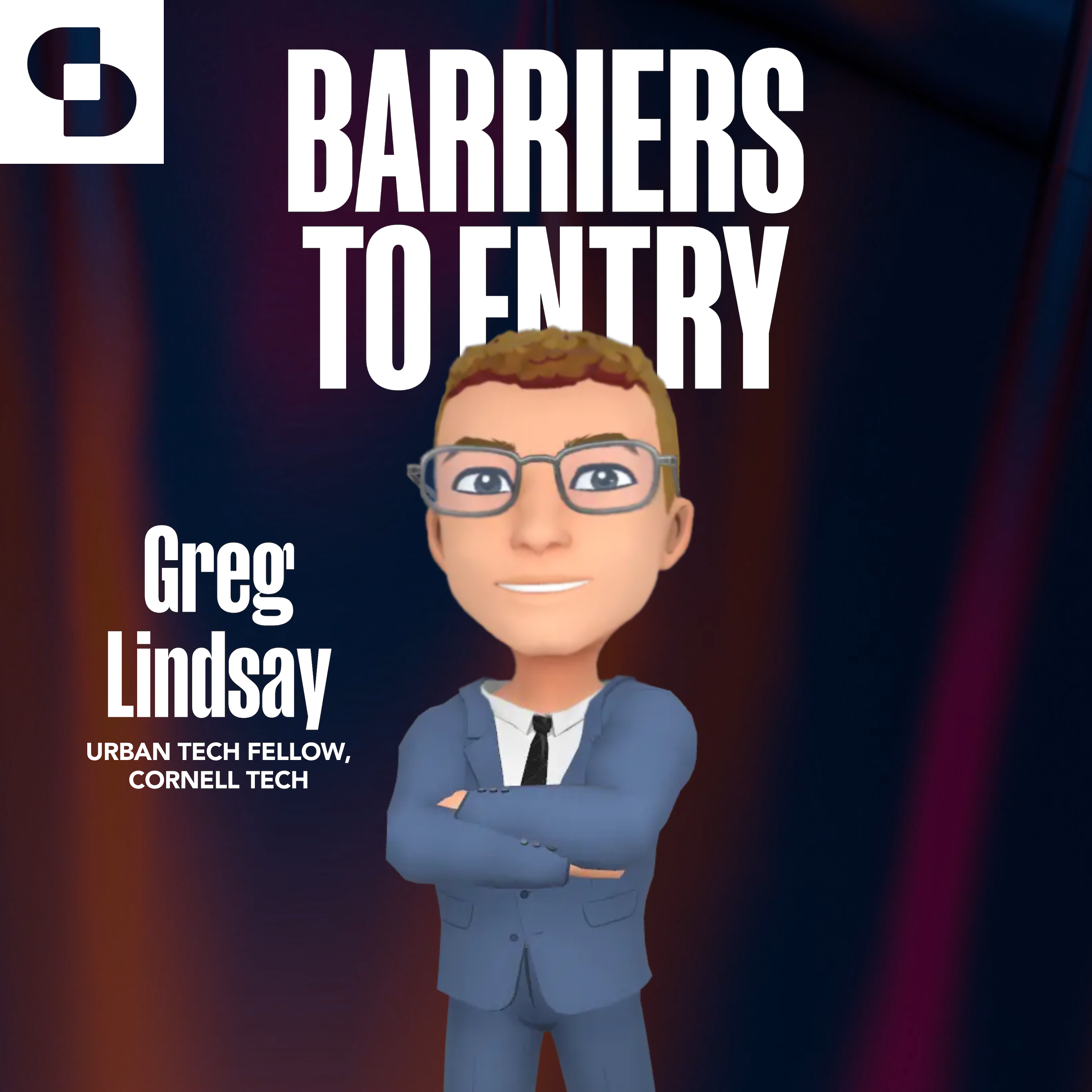For our season premiere of Barriers to Entry, we welcome our guest Jaime Derringer, Founder of Design Milk, NFT artist, and currently the Head of Community at Tonic, a new fine art NFT platform for creators. On this episode Jaime shares what it was like to be one of the Web2 pioneers, the similarities she’s experiencing in Web3, and the curiosity it takes to be leading the charge at the brink of new technologies.
Connect with Jaime Derringer on LinkedIn! Keep up with Tonic on Twitter!
Moments to check out;
- Can Web3 fix social media? (9:15)
- Do you see an application for Web3 in the A+D community? (11:46)
- What got you into NFT art? (27:19)
- Episode takeaways (29:37)
Connect with our hosts on LinkedIn;
Discover more shows from SURROUND at surroundpodcasts.com. This episode of Barriers to Entry was produced and edited by SANDOW Design Group.
Special thanks to the podcast production team: Hannah Viti, Wize Grazette, Kasey Campbell and Samantha Sager.
[00:00:00] Bobby Bonett: Welcome to Barriers to Entry, the new podcast where every episode we’re gonna get into it with the leaders, the designers, the early adopters, and the influencers who are helping to. What web three, the metaverse, the blockchain and more will mean for the architecture and design industry. I’m Bobby Bonnet, and I’m joined by my two esteemed co-hosts, Andrew Lane and Tess Bain.
Welcome, welcome.
[00:00:25] Tessa Bain: Thanks, Bobby.
[00:00:25] Andrew Lane:
it’s great to be here and we’re so excited for the first episode.
[00:00:29] Bobby Bonett: because it’s our first episode. I’d love to share with our listeners a little bit about Andrew and Tess and Digby. So do you all mind filling in on where you come from and where your credentials are that would make you the right, two parts of the try, hosts of Barriers to Entry.
[00:00:43] Tessa Bain: So my background’s in the design and architecture industry, I’ve always worked on behalf of manufacturers or for dealers, in either, textiles or in furniture.
My passion for authentic design, specifically, I’m a huge fan of authentic design furniture, was a really natural sort [00:01:00] of foray into this space when we first kind of discovered about a year ago, all of the new technology in Web 3 and thinking about how can we bring that technology to the design industry.
[00:01:11] Andrew Lane: For me, my dad used to broadcast, the local hockey team on access cable, and I get used to, yeah, I used to help out with that back in the day. So my podcast trajectory really started on, uh, local cable, in rural Ontario, Canada.
So I don’t know if you can think of a more appropriate rise. But, if I needed any other credentials, I was, uh, doing an awful lot of work at the dawn of Web two really helping brands and businesses to make their first mark in that space. And when we started Digby, we said, you know, this is an opportunity in web 3 as well.
So Tessa’s background and the industry and, and mine and the technology side felt like a good pairing. But what about you, Bobby? How did you get here?
I’m leading digital and strategic growth at SANDOW Design Group, , which is a multi-platform collective of media services and networks, brands in the architecture and design industry.
[00:01:58] Bobby Bonett: Two of those brands, Are [00:02:00] closely tied into this podcast. One is the Studio by SANDOW a creative Production Studio, which is producing the show, and one is the SURROUND podcast network. A collective of podcasts, from the architecture and design industry. And Barriers to Entry is a proud member of the SURROUND Podcast Network.
[00:02:16] Andrew Lane: So that’s really where we are here is we’ve got the industry expert, the tech/local cable expert, and then the plugs guy. And we hope that that balance is really gonna bring you some entertainment, but most importantly bring you great conversations, with some exciting guests.
And so really to get us started this week, we couldn’t be more excited, for our first guest, you know, she has been so well known. In our industry. she was the founder of a major, independent media outlet. She’s now actually working in the Web 3 space. and if you’re doing anything on LinkedIn in either the design or the Web 3 industry right now, there’s a good chance she’s commenting on your posts and or resharing them.
we’re really excited to have Jaime Derringer joining us And, we were just super excited to be able to to, to track her [00:03:00] down and, and to sit down with her.
[00:03:02] Bobby Bonett: So we’re excited to share with you, the interview now, which was taped at Penn 1, in New York City.
we’re excited to share with you. enjoy.
[00:03:10] Andrew Lane: So we’re so excited to bring on our guests today. She is the founder of design milk, which many of you will know? She is currently the head of community at Tonic, which we’ll get into a little bit more further.
And she’s also our LinkedIn follow of the month. So we’re very excited to have Jaime Derringer join us on the pod today. Welcome Jaime.
[00:03:28] Jaime Derringer: Oh, so great to be here. Thanks for having me.
Andrew Lane: We know that you’ve been an entrepreneur in this space for some time you started Design milk back in 2006.
[00:03:36] Andrew Lane: I almost said way back. I don’t wanna, well, it is
[00:03:38] Jaime Derringer: way, way back,
[00:03:40] Andrew Lane: is it way now?
[00:03:41] Jaime Derringer: Way way.
[00:03:42] Andrew Lane: Oh, geez. Yeah. I heard recently that they’re calling people who did things in the, 1990s as people from the 1900. Oh man. Yeah, I know. But 2006 is pretty modern compared to that. That was right in the heart of the web two revolution.
Can you tell us about the lay of the lane at that point in time and how you’re seeing similarities [00:04:00] to where we are today?
Jaime Derringer: yes, I started design milk. It was web two, but it was early web two. So, at the time. You know, blogger, very early days of Facebook and Twitter. and there was a lot of excitement.
[00:04:12] Jaime Derringer: I mean, when I started design milk, there were, not a whole lot of people publishing online. Mm-hmm nobody really knew what I was doing. Didn’t really understand blogging. In fact, my husband called it me playing on the internet. That was like his, yeah. And I was like, no, wait, this is gonna be my job.
Just wait. And that’s kind of how I’m feeling today. with web three. So it’s it parallels that in the sense of like, there’s a lot of new roads to be paved and new and exciting things that are going to happen. And I love being at the start of that.
Bobby Bonett: So Jaime, tell us about Jaime 3.0, because I know you’ve developed that persona for yourself.
[00:04:47] Jaime Derringer: it was kind of accidental came about in a conversation with a friend talking about web one, web two and web three. my web one was just education and growing up web two was me, finding myself, starting a business, selling that [00:05:00] business. And Jaime 3 is, I’m not really sure yet. I’m just really excited about, what’s next.
[00:05:06] Bobby Bonett: Well, would imagine part of that excitement comes from the fact that you are unsure about what Jaime 3 might be, which is similar to where we sit as it relates to what web three is
[00:05:16] Jaime Derringer: going to be. Absolutely. And I think that that to me is the most exciting part of all of this. Curiosity has really been at the heart what I do, and who I am as a person.
And so not knowing and being curious and experimenting and just. trying to figure out what’s gonna happen to me is like what keeps me going.
[00:05:37] Andrew Lane: I love your story about your husband. And you talked about, you know, this is gonna be my job someday. can you talk a little bit about what that feeling is to just have that certainty amidst uncertainty?
Jaime Derringer: I do a lot of things in my life. Going by my gut. So I don’t even know like where it comes from, but it is just a feeling that I start to get kind of tingly and excited and I wanna talk to [00:06:00] people and I wanna ask a lot of questions and I wanna fill my brain with new information that I know nothing about and explore new territories.
[00:06:07] Jaime Derringer: And that’s where I’m at right now.
[00:06:11] Andrew Lane: I think when you get out and you’re early to something and you start to find those people that you can communicate with that community that you can build, it gets really exciting. what are some of those other parallels , that you’re kind of feeling to the way web two rose up to what we’re seeing right now?
[00:06:24] Jaime Derringer: Yeah, there was just a lot of exploration. There were a lot of companies just trying new things, throwing things at the wall, seeing what stuck, a lot of collaboration. and I think that that’s also what we’re seeing here. Nobody really knows what web three. Is, and I think that that’s okay.
Andrew Lane: a playbook can sometimes be quite boring.
Jaime Derringer: Well, I like looking at things from the perspective of being like an outsider. I like to come in not knowing anything and ask the questions that other people might not be thinking about or asking. And I think when there is a blank slate or a blank canvas, it’s like, you can just ask all of the questions.
Tessa Bain: [00:07:00] speaking on that, about being early, we all kind of have this conversation, you know, it’s an easy thing to say in the industry right now is like, oh, we’re very early. so I wanna get your take on that too, but, Specific to the architecture and design community. Why is it important to be early?
Jaime Derringer: I think being an early adopter, we’ve seen this on social media platforms. As you get more followers, if something starts to take off mm-hmm so that’s the first thing is like growing your audience and growing in a very rapid way.
but I also think that being early helps you become a leader faster, cuz people will look to you as to. You know, some people really need a playbook and they want somebody to follow mm-hmm
[00:07:40] So being able to be at the forefront of that and leading this charge into this new and new territory that you’re exploring, even though you don’t have all the answers, other people think that you do mm-hmm . And so I think it, you can carve out like a path for others.
[00:07:56] Andrew Lane: I think that’s the dirty secret, right? Is the people who. think someone’s a [00:08:00] leader, but really they’re just kind of figuring it out as well. They’re just maybe good about keeping more tight lipped about it. Mm-hmm I think that’s, what’s exciting in these times is it’s a chance for leaders to emerge, but we don’t know where they’re gonna quite come from all the [00:08:09] time.
Jaime Derringer: And really now it’s like anybody’s game, right? Anybody can jump in right now, just like in 2006, anybody could start a blog
[00:08:17] Andrew Lane: I think it’s a good segue into, our LinkedIn influencer the month convo, because you’ve certainly, used this as an opportunity to really get out there.
What have you learned, from putting yourself out?
Jaime Derringer: Well, first of all, LinkedIn to me is quite new as, a community. I didn’t really post much on LinkedIn. and now I’m on there all the time and it’s becoming a really exciting place to be. there’s a lot of people doing new things on LinkedIn. And so just being able to get out there and ask questions and be able to be seen by professionals, in design or in web 3 or in technology, and then follow other leaders and just keep tabs on what they’re doing and what kind of conversations they’re having, what kind of news they’re seeing. it’s a really awesome [00:09:00] way to connect with other professionals, but it’s. Way more fun, I think, than it used to be.
[00:09:06] Andrew Lane: yeah, I was gonna say, I feel like LinkedIn, if you would asked them in 2006, if they were gonna be the fun, exciting place to be, I don’t know how many people would’ve predicted that, but it’s really interesting what that platform itself has just evolved itself into. and that there’s these tools that now exist on the back of web two to help build, new opportunities in new spaces.
Bobby Bonett: One thing you had shared over the summer is that, you feel as though, and I’m gonna quote you, Jaime “social media is dead and it’s effectively being replaced by recommendation media and other, not bold, other kind of sub formats it’s bold with within social media, very bold.” but you did ask whether web three could be a solution to fix where social media evolved or maybe devolved to.
so where and why, and how do you feel at web three may be a solution. Getting us back to the glory days, if you will, of social media.
Jaime Derringer: There’s a couple of things. the first thing I would say is that with web three, [00:10:00] there’s a migration to. More ownership over your community. So instead of being beholden to Facebook and whatever they decide to do, you know, corporate strategy or algorithm changes that could potentially disrupt, or even end your business overnight, you move your community somewhere where you have total ownership over that community, and then you can bring them wherever you want to.
[00:10:26] And I think that putting the hands back into the creators. The entrepreneurs, the companies, instead of being beholden to these large corporations that really don’t care about small business growth or, small communities, I think that’s really important. So that’s one big part of it that I think is super important.
And then I forgot the second part of the thing I was.
[00:10:47] Andrew Lane: I think can lean into that first part. Cause it was a really good one. Like this idea. A true, like authentic collaboration in community is something that obviously resonates with our industry as well. that was something that web two always had as its headline, [00:11:00] but it never really lived up to the promise because I think that those companies got too big, too fast, but they were definitely big.
Jaime Derringer: You actually reminded me of my second point, which was, that was my plan decentralization.
[00:11:10] This worked out really great. Web 3, one. components it’s a little idealistic, but the idea of decentralized communities so that the community has a little bit more ownership over what happens to the company or the brand or the community, as it grows, making decisions with your community, having them invest time and energy in the things that they want to see instead of what you think they want.
so I, I love that idea. it won’t work for everybody, but I still think there’s just something. There’s a lot of like power to the people. and I, I love that.
[00:11:44] Andrew Lane: I don’t know if you can own that quote, but no, I don’t.
[00:11:46] Tessa Bain: Yeah. do you see an application for that in the a and D community? Like I’m interested to see where decentralization plays there?
[00:11:53] Jaime Derringer: A hundred percent? I do. so from a decentralization perspective, This leads me into what we’re doing [00:12:00] at tonic, which is building an interior designer community, or a community around interior design, lovers and professionals. We are working with them to teach them and help them learn about web 3 NFT’s, metaverse all of the things that are happening or going to be happening and we’re all holding our hands together and saying, let’s figure this. As we go, we don’t have an answer for them right now, but we know it’s gonna happen. And we’re all gonna have to get there at some point. So why not have them come on board now and we’ll figure it out together and that’s building a community. And to me, that’s, it’s decentralization in a way.
[00:12:39] Tessa Bain: Mm-hmm, it’s such an interesting approach too. And it’s one of the things that I loved about our early conversations together, too. It was your ability to say, you know what? I don’t know. And I’m comfortable saying, I don’t know everything, but I’m here to learn. And I think it creates a really open and welcoming space.
[00:12:52] Jaime Derringer: Yeah. We’re all here to learn. Mm-hmm and I think that’s the ideas here. Like let’s learn this together and figure out. What the industry needs. Just [00:13:00] think about the power of the designer. If you think about the metaverse right. You’re talking about a space that doesn’t really exist physically mm-hmm so the opportunities are limitless and you can create whatever you want.
So the possibilities for expanding businesses. Growing new ways of new revenue streams, a new economy. Mm-hmm, , there’s so much excitement, but there’s a lot to be built there. And designers need to be at the front line of this, not waiting at the end to figure out what’s left over. And I think with the design community, a lot of times they’re the last to adopt technology.
And so what I really wanna do is get them a step ahead. because I think we need as a design community to shape what these experiences look like, feel like how can we incorporate things like wellness, sustainability into the metaverse?
[00:13:49] Andrew Lane: Yeah, really well said. I think that that’s one of the things that is the hardest to get to is that where everyone feels welcome.
I think that immediately technology puts up a barrier, for people [00:14:00] and it makes people. Geez. Tess and I were with partners earlier today and the second we used the word metaverse the conversation ground a little bit slower. Let’s just say, because people don’t just lean in naturally to these kinds of areas, but I think it is a curious industry.
So, you know, we’re talking about curiosity here. how do you use the curiosity to overcome that barrier?
Jaime Derringer: I think it’s about getting people excited about the potential. So maybe there’s a way to do it where, it can be a much more visual, way to onboard people. Let me show you what’s possible.
[00:14:33] What can we create that will allow you to see visualize or experience what the future will be like? And don’t you wanna play a part in that? Mm-hmm is really the question I wanna ask. Don’t you want to create a vision, an experience for people to do business inside of, or work together on or build together?
[00:14:53] Tessa Bain: And I think also the lack of representation from our community in the early days of the space of metaverse is something that [00:15:00] anyone in the design industry has seen and sort of, you can see it and has said, Hey, like, you know, there’s a real role and space for this skillset and it’s needed obviously, when you go through some of the platforms.
[00:15:15] Jaime Derringer: I feel like sometimes when you give people limitless possibilities, they just freak out. Mm-hmm , it’s too much. It’s overwhelming. Even designers. It’s like, ah, I need specifications. I need a deadline. I need something to get started. And for the average business owner like people you might have talked to earlier today.
They don’t want to be in a space that looks like a video game or Tron, or like a planet like they want the replication of the real world mm-hmm and this is where I feel like really awesome applications for designers are gonna come into play here because designers need to design virtual conference rooms, virtual spaces that replicate what we have in the real world first, because you have to slowly hold people’s hand and walk them into this experience very slowly.
[00:15:58] Andrew Lane: Yeah. From a mass adoption.
[00:15:59] Jaime Derringer: Yes.
[00:15:59] Tessa Bain: And [00:16:00] we talk a lot about this at Digby, actually, something that Andrew says a lot is that, you know, if you’re to walk into a metaverse boardroom, there’s a table in chairs and it’s not so much that, I mean, I’m stealing your line, Andrew.
This is actually hit, just hit it, absolutely yours. It’s not that we need that in a metaverse, but it’s that we need to understand how to orient ourselves in a room full of people for that meeting and for that purpose. Taking it from 10,000 feet and bringing it down and speaking about true application.
We have so many clients that are investing millions of dollars in their physical spaces and the culture, the return to work conversation about how do we bring people back? Well, we may never go back full time or we may, but how do we express that culture in the virtual sense in extension to our physical spaces?
Jaime Derringer: I’ve been talking to a lot of designers who. Really curious about the possibilities. They wanna understand like how they can showcase their work in the space. which I think is really the first step to being able to work with, a business to develop a virtual conference room, show off what you can do digitally.
[00:16:58] And a lot of them already [00:17:00] have the files and mm-hmm, it’s not that difficult to really get it into a virtual like metaverse type environment. Mm-hmm so, I think it’s, just a matter of having these conversations and really that’s, what I’m trying to do with Tonic is speak to as many designers as possible to get them excited about these possibilities and have them understand that this is a whole new potential business model for them.
There’s so much that they can do… it’s not tech for tech stake. It’s how do we solve a problem that you have at your business? Are you having trouble getting people back to the office? Let’s figure out a way to solve that. So are you having trouble getting clients to see your work, online let’s come up with a solution for that.
[00:17:43] Tessa Bain: I think it was McKenzie came out and said that the. Consumer of the future expects this experience from retail. And it was something that was 73% and it was millennial and younger. And they’re fully expecting that businesses are evolving. but what would you say though, to someone. Who [00:18:00] maybe feels intimidated by the fact that, we’re early. And what if someone, a designer or a firm is not ready today, but is curious tomorrow.
Is there such thing as not coming in at the right time?
[00:18:12] Jaime Derringer: I think you just don’t wanna be really late mm-hmm because you don’t wanna be in the situation where you’re scrambling to figure out how to get all your team members on a zoom meeting to just have a normal business meeting online during a pandemic. So I think there is exploration there’s education. There are lots of things you can do in your company. Where you’re not actively building something, but you are talking to people about it and you’re exploring it with your team and you’re asking your team what they might need or want, or what are the opportunities for this technology within our company.
Bobby Bonett: You’re absolutely right, Jaime, because you’re irrespective of a leadership team’s comfortability or how bullish they may be about web 3. [00:18:58] Every business is going to have [00:19:00] somebody who works at that company who is geeking out about web 3, and they probably have some ideas about how their business might be able to take advantage of the landscape, and that’s a great person to listen to because at some point you have to take that first step and understand what is the opportunity for my business.
[00:19:15] Andrew Lane: Isn’t it, the worst though, when the person Bobby just described isn’t even paid attention to right. They’re there and they’re, they’re doing a side project and it’s not even something that’s part of the conversation at that company because they don’t feel like they can bring it to their work.
[00:19:29] Jaime Derringer: Yeah. And I, I think because we’re in a situation where there really is no right answer, there’s no wrong answers either. So having a brainstorming meeting with your team about what could happen within your company is, super valuable to have everybody participate, just because there is no right or wrong answer at this point, and you can just figure it out together.
[00:19:54] Andrew Lane: Do you think that cultural piece is hard for some organizations to say that there is no right or wrong [00:20:00] answer?
[00:20:01] Jaime Derringer: Absolutely! I think there’s probably ego involved. There’s probably boards and investors and other things that you have to answer to. but within a company, I think it’s really important to have great communication with your team. So even if you’re in a smaller leadership role, and you’re just speaking with your immediate team, it could start there.
And then that team could say, Hey. Senior leadership. We’ve got this idea. We’d love for you to hear it. And just getting heard is the first.
[00:20:30] Tessa Bain: Wonderman Thompson. I mean, not to keep quoting all of these consultancy documents.
Andrew Lane: But you’re quoting everybody today. Tess it’s great.
Tessa Bain: Well, these are important stats and I love a good stat, but they had interviewed a bunch of senior leadership and executives, and they were aware of web three and all of the things and emerging tech, I mean, this included of course like AI and, and VR and all these other platforms as well.
Their biggest constraint they felt was not having the resources or the support to be able to do this internally. And the second thing is that if they didn’t, they didn’t [00:21:00] know where to turn, to look for these resources and support. Do you think that’s kind of a call to the industry to, to start, to be able to be that voice?
[00:21:08] Jaime Derringer: Well, yeah, I do. And I also think you have to ask your team like, Hey, do you wanna learn about this? Great. I’ll get you some education. There’s lots of things online there’s lots of webinars and education programs. I know there’s some LinkedIn certification stuff. I think Wharton is doing some business stuff in web 3. So I there’s resources out there to learn it. Nobody’s really an expert in any of this stuff right now. So there is opportunity for people to step up say, you know what? I’m really curious and interested, teach me like, “hey company, I wanna be this person that starts this division in our company, or leads this charge.”
[00:21:43] Bobby Bonett: You’re so right, Jaime I mean, we we’ve seen over the summer several large brands in our industry hire or elevate heads of web three or create web three departments. I remember my first job, I was the company’s first social media coordinator. And now what brand doesn’t have a digital marketing or social [00:22:00] media marketing department.
And it’s probably about the right time in the next one or two years for businesses really to take seriously. The idea of when I look at my hiring roadmap. I need an individual who’s responsible for pushing our organization in the right direction so that we are well positioned when we’re no longer quote unquote early on web 3.
Tessa Bain: It’s interesting too, because we keep saying early and no doubt we are. We as an industry are a little bit behind. If you look at fashion and you look at art, I mean, they’ve been doing this for a few years now and they’ve rode this wave of the high and the low of the NFT and, you know, they’re redefining themselves and the utility and their, new revenue streams.
[00:22:39] It’s very successful. I mean, as manufacturers and as architects and designers, we can really look. Everything they’ve done right or wrong. but we maybe don’t need to be so afraid. We’ve watched people go through and make mistakes already and then learn.
[00:22:52] Jaime Derringer: I think if you wanna be successful, you cannot be afraid of failing. I have failed so many times and [00:23:00] I’m still here to tell you that I will probably fail here and there again, make lots of mistakes. I’ll make all the mistakes.
And then I’ll tell you. not to make them because I did them all. you just can’t be afraid of that. and I think you can see what’s been successful. but that might not even apply to your industry.
Right? So while Instagram might wanna do be real, maybe their customers don’t want that. So it might not make sense for you to do a, an NFT drop to your community. It might make sense for you to build a virtual space where they can interact. So I think it’s just figuring. what’s gonna work for your business and your customers instead of following someone else’s lead
.
[00:23:37] Andrew Lane: It starts to turn into a bit of an analysis paralysis. Well, am I, am I not early enough? Am I too late? What happens if I do something and
[00:23:42] Jaime Derringer: now I’m just start, just start, just do something, anything.
Bobby Bonett: A great example of that, is how long have we been talking about the trade show of the future now? every year there’s a panel. There’s a hum about what’s this trade show going to look like next year? How will it be augmented? What does web 3 look like for this trade show? [00:24:00] And I feel like at some point you need to say, all right, I’m gonna put a stake in the ground and say, this is what the future means for my business. Or at least let me try something out. That’s a little bit funky this year and see where this might [00:24:08] take us.
Andrew Lane: I think people just want their feet not to hurt as much as part of the trade show.
[00:24:12] Jaime Derringer: Yeah. If someone could figure out how to innovate. Footwear. Yeah. That allows us to glide. Yeah. Along all day.
[00:24:18] Andrew Lane: There’s like many solutions there. It reminds me of back in the old web 2 days, I was on, a marketing association, the mobile council and every single year for multiple years, we’re like, it’s gonna be the year of mobile.It’s gonna be the year of mobile. We said it every single year until it was like, oh wait, it was actually two years ago.
It just sort of happens. People just sort of adopt things. And if you’re waiting around for it to happen, it’ll pass you by.
Jaime Derringer: Yeah. And I think getting outside of your regular bubble of conversation, because as we’ve been talking about a little bit, these algorithms are in control of what we see here every day online and what we read. Even if you just follow two or three people in a completely different realm, you’ll be fed a lot of new information. I’m a big,[00:25:00] proponent of getting outside of your bubble, stepping outside, seeing what else is out there and then thinking about how it might apply to whatever it is that you’re doing in your business.
[00:25:13] Andrew Lane: There are people out there definitely who are telling us what this will be. I think we are a little too early to know exactly what this’ll be in 2006. We never, would’ve been calling LinkedIn the fun place to be , but here we are 16 years later. Right. So I think we also have to, consider the fact that there, even as much as we’re talking about community and decentralization and all these very wonderful things, people have business motives upon what they’re saying.
So when you do step aside of your bubble and you learn a little. Start to expand out even further is what I would say.
Jaime Derringer: And that’s why I think conversations, like what you’re doing here are really important because there’s no real answer. If someone’s telling you exactly what something is definitely going to be, I would say that’s a red flag and to say, well, wait, let me look at it from this perspective.
[00:25:51] Or have you ever thought about it like this.
Tessa Bain: To put it fundamentally too. I mean, the perfect example is the debate of wearables and or non [00:26:00] wearables.
Jaime Derringer: there are a lot of glasses in development and there’s a lot of screens in development, so I can see it going kind of both ways or all of it. you know, there’s no right answer. I don’t know, but I would love to see all of the options cuz I like options. Mm-hmm I don’t like the idea of wearing a headset, so glasses are great. but I might not wanna wear glasses eight hours a day. I might wanna sit in front of a screen or walk into a room that has immersive technology built into the walls.
And then the whole thing transforms and I’m in a room with like 16 other people. so I, I think we’ll see a lot of iterations of that and some companies will be really successful at it and others will not. We’ll just have to wait and see, but I can envision all of those options.
Bobby Bonett: So Jaime you’re an NFT artist among, as we know many other things and your digital sand worms collection for example, is on Opensea.
[00:26:49] What got you into NFT art and where are you excited to continue to experiment there?
[00:26:54] Jaime Derringer: Well, my whole web 3 journey started with NFT art. So I was curious, cuz I had been doing, art [00:27:00] on my iPad for a long time, trying to figure out what to do with all this digital work that I was making and I fell down a rabbit hole on Twitter.
Met a lot of NFT artists, got immersed in that community fairly early last April, minted, probably 200 NFTs or even more than that. And, yeah, it’s been such an awesome opportunity and that’s kind of how I got introduced to everything and how I’ve met all of these really interesting and fascinating people in the world of web 3.
And at some point during that art journey, the business wheels started to turn in my brain. and so that, that’s why I’m here now.
Tessa Bain: Love speaking with you. I think it’s always so fascinating to hear, what you’re learning and, what you’re doing and what you’re passionate about,
[00:27:43] And so for our listeners, where would you point them for resources, or anything that could help them in this journey?
[00:27:50] Jaime Derringer: Well, obviously this podcast is the best resource, right?
Andrew Lane: that’s the correct answer.
Jaime Derringer: Thank you. follow me on LinkedIn would be also fantastic.[00:28:00]
if you’re on LinkedIn or Twitter, there’s a lot of conversations in web three. So, get on there, do a search, see who the top followers are, start listening in, On Twitter, same thing. There’s a lot of conversations happening there as well. You could even consider joining a web three community and there’s a lot of education and connections that you can make there as well.
I would say, just get out there and do a Google search type in web 3 in any of your social media platforms.
you could also follow Tonic at Tonic_xyz on Twitter and Instagram, or join the community. We’d love it!
[00:28:37] Andrew Lane: That’s awesome. Well, thanks so much, Jaime. It was such a pleasure having you on today. Can’t wait to see, the next LinkedIn post and everything else that comes from all your great work.
[00:28:45] Tessa Bain: Jaime’s great, isn’t she?
[00:28:47] Andrew Lane: I think, I think we all can vote that we love, we love Jaime and it was great having her on as our first guest, and we play with time a lot in this magical world of, of recording here at SANDOW.
But uh, that was [00:29:00] actually our first podcast recording that we did. That was, that was legitimately all of us on our, our rookie voyage. Our maiden voyage.
[00:29:07] Bobby Bonett: so. what we like to do after each episode is share a quick takeaway or something that stuck with us, um, in the days and weeks that followed the interview.
So I’ll go first and I really, you know, as somebody who works in the digital space, thought it was super interesting. Jaime proclaiming the death of social media and it’s being replaced by recommendation media. and as somebody who’s still wrapping their mind around, you know, the opportunities that.
decentralization technologies that form the bedrock of Web three present and getting away from recommendation media and the endless scroll. It gives me hope for the ways in which creative people will try to unlock metaverses and, and web 3 and so on,
[00:29:46] Tessa Bain: I was really, inspired by her. Telling us, like, just try, you know, like she said in the very beginning when we first talked to her, I don’t know where I’m gonna end in this. , but I do know that I’m following a thread and I’m following the energy and it’s brought her to Tonic.[00:30:00]
[00:30:00] Andrew Lane: What, she’s presenting is just a mindset that really allows you, , to not worry about what the technology is that might get in your way and not, not worry about the how.
At the outset, it’s really just about learning and about, you know, building the community around you as well.
[00:30:15] Andrew Lane: I think that one of the other really surprising outcomes, and maybe one of our favorite, uh, side jokes from the episode was just the degree to which Jaime’s really leaning into LinkedIn and how LinkedIn has become this broadly powerful platform for anyone who’s looking to learn about this new Web 3 space and, and the intersections between design, uh, between architecture, between web 3 and the metaverse are just apparent every single day on that platform. So it’s something really exciting to hear her talk about and how she really got in. And that’s really why we called this first episode, curiosity 101.
[00:30:49] Bobby Bonett: By the way, I, I do wanna go back for a second and note that LinkedIn’s not the sponsor of this podcast
[00:30:54] Andrew Lane: No,
[00:30:54] Bobby Bonett: Now if they’d like to sponsor, they can contact our producer, Sam Sager, and learn more.
[00:30:58] Andrew Lane: All right. Let’s, let’s close this [00:31:00] out. Um, big thank you to our production team, Sam Wize, Hannah, and the whole team at the studio by SANDOW. Barriers to Entry is a part of the SURROUND podcast network, so make sure that you go to surroundpodcasts.com.
That’s podcasts with an ‘S’ and be sure to smash that follow button. Uh, that’s what the kids say now, right?
[00:31:22] Bobby Bonett: Be relentless.
[00:31:23] Andrew Lane: Be relentless. You actually only need to do it once. It’s a very gentle click. But we’d love it if you could share the podcast, we have more exciting episodes to come.
[00:31:31] Bobby Bonett: Thanks to Vornado shouts to tornado for us being in person today.
[00:31:35] Tessa Bain: Join us next time as we continue to break down the Barriers to entry.

